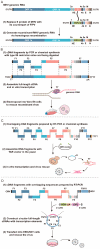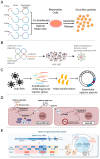Design and Application of Biosafe Coronavirus Engineering Systems without Virulence
- PMID: 38793541
- PMCID: PMC11126016
- DOI: 10.3390/v16050659
Design and Application of Biosafe Coronavirus Engineering Systems without Virulence
Abstract
In the last twenty years, three deadly zoonotic coronaviruses (CoVs)-namely, severe acute respiratory syndrome coronavirus (SARS-CoV), Middle East respiratory syndrome coronavirus (MERS-CoV), and SARS-CoV-2-have emerged. They are considered highly pathogenic for humans, particularly SARS-CoV-2, which caused the 2019 CoV disease pandemic (COVID-19), endangering the lives and health of people globally and causing unpredictable economic losses. Experiments on wild-type viruses require biosafety level 3 or 4 laboratories (BSL-3 or BSL-4), which significantly hinders basic virological research. Therefore, the development of various biosafe CoV systems without virulence is urgently needed to meet the requirements of different research fields, such as antiviral and vaccine evaluation. This review aimed to comprehensively summarize the biosafety of CoV engineering systems. These systems combine virological foundations with synthetic genomics techniques, enabling the development of efficient tools for attenuated or non-virulent vaccines, the screening of antiviral drugs, and the investigation of the pathogenic mechanisms of novel microorganisms.
Keywords: application; biosafety; coronavirus; pseudovirus; trans-complementation system.
Conflict of interest statement
The authors declare no competing financial interests.
Figures





Similar articles
-
A trans-complementation system for SARS-CoV-2 recapitulates authentic viral replication without virulence.Cell. 2021 Apr 15;184(8):2229-2238.e13. doi: 10.1016/j.cell.2021.02.044. Epub 2021 Feb 23. Cell. 2021. PMID: 33691138 Free PMC article.
-
Comparative pathology, molecular pathogenicity, immunological features, and genetic characterization of three highly pathogenic human coronaviruses (MERS-CoV, SARS-CoV, and SARS-CoV-2).Eur Rev Med Pharmacol Sci. 2021 Nov;25(22):7162-7184. doi: 10.26355/eurrev_202111_27270. Eur Rev Med Pharmacol Sci. 2021. PMID: 34859882 Review.
-
A novel cell culture system modeling the SARS-CoV-2 life cycle.PLoS Pathog. 2021 Mar 12;17(3):e1009439. doi: 10.1371/journal.ppat.1009439. eCollection 2021 Mar. PLoS Pathog. 2021. PMID: 33711082 Free PMC article.
-
Current status of antivirals and druggable targets of SARS CoV-2 and other human pathogenic coronaviruses.Drug Resist Updat. 2020 Dec;53:100721. doi: 10.1016/j.drup.2020.100721. Epub 2020 Aug 26. Drug Resist Updat. 2020. PMID: 33132205 Free PMC article. Review.
-
Similarities and Dissimilarities of COVID-19 and Other Coronavirus Diseases.Annu Rev Microbiol. 2021 Oct 8;75:19-47. doi: 10.1146/annurev-micro-110520-023212. Epub 2021 Jan 25. Annu Rev Microbiol. 2021. PMID: 33492978
References
-
- Kapikian A.Z. The coronaviruses. Dev. Biol. Stand. 1975;28:42–64. - PubMed
Publication types
MeSH terms
Substances
Grants and funding
- 2021YFA0910900/National Key Research and Development Program of China
- 32222044/National Natural Science Foundation of China
- 22104147/National Natural Science Foundation of China
- RCYX20210609103823046/Shenzhen Municipal Science and Technology Innovation Council
- 2021359/Youth Innovation Promotion Association CAS
LinkOut - more resources
Full Text Sources
Miscellaneous


